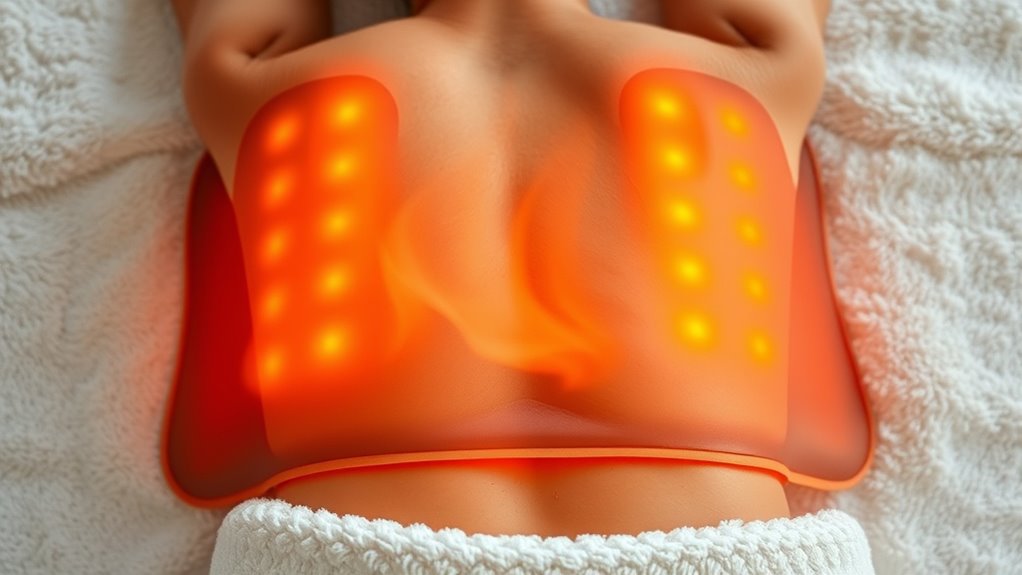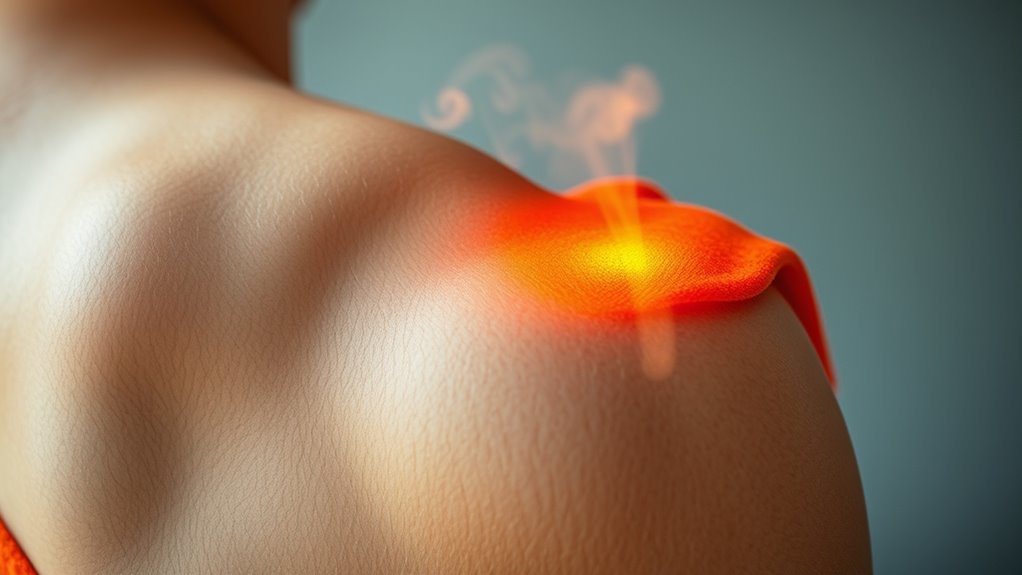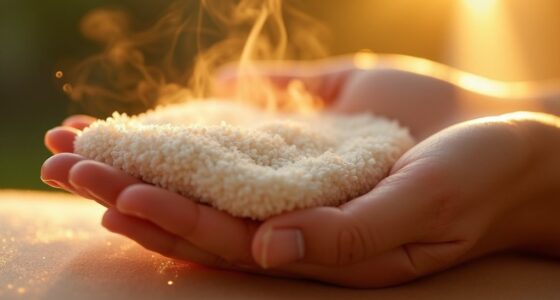Applying heat through thermotherapy helps loosen tight muscles and ease tension by increasing blood flow to the affected area. This deep warmth relaxes muscle fibers, reduces stiffness, and soothes discomfort. It also promotes the removal of inflammatory chemicals and brings in fresh oxygen and nutrients, speeding up healing. When used correctly, heat therapy can quickly relieve muscle tightness and pain. Keep exploring to discover more ways to benefit from thermal treatments and stay comfortable.
Key Takeaways
- Heat penetrates deep into muscles, promoting relaxation and reducing stiffness.
- Thermotherapy increases blood flow, delivering oxygen and nutrients to support muscle healing.
- Applying heat decreases muscle spindle and nerve activity, easing muscle tension.
- Consistent warmth helps break the cycle of pain, spasms, and stiffness.
- Proper heat application reduces discomfort and accelerates recovery safely.

Thermotherapy is a treatment that uses heat to relieve pain, reduce stiffness, and promote healing in injured tissues. When you apply heat to the affected area, it penetrates deep into your muscles and tissues, offering targeted relief where you need it most. This process, known as heat penetration, helps increase blood flow, which accelerates the delivery of oxygen and nutrients while removing waste products. As a result, your muscles loosen up, easing tightness and discomfort. You’ll notice that with consistent heat application, your muscle tension diminishes, making movement more comfortable and less painful.
One of the key benefits of thermotherapy is muscle relaxation. When heat is applied, it causes your muscles to relax by decreasing muscle spindle activity and reducing nerve activity that causes tightness. This relaxation isn’t just temporary; it can help break the cycle of pain and stiffness that often accompanies muscle injuries or chronic tension. As your muscles relax, your range of motion improves, and you’re less likely to experience spasms or cramps. This makes thermotherapy particularly effective for conditions like muscle strains, tension headaches, or joint stiffness.
The warmth generated during treatment also helps soothe sore tissues, reducing the sensation of pain. When your muscles are relaxed and blood flow is increased, your body’s natural healing processes are stimulated. This promotes faster recovery and lessens the likelihood of further injury. It’s crucial to recognize that heat therapy should be carefully timed and applied at the right temperature to avoid burns or excessive swelling. Typically, sessions last between 15 to 20 minutes, and you should always use a barrier like a towel between the heat source and your skin to prevent burns.
You’ll find that heat penetration is most effective when the heat source is applied consistently and directly to the skin. Using heating pads, hot packs, or warm towels can help you achieve a steady, penetrating warmth that reaches deep tissues. This not only enhances muscle relaxation but also encourages blood vessels to dilate, which helps carry away inflammatory chemicals and bring in fresh oxygen. Additionally, appropriate heat levels are essential to maximize benefits and prevent injury during thermotherapy. Over time, this reduces muscle tension and accelerates healing, making thermotherapy a simple, non-invasive way to manage muscle pain and stiffness. Whether you’re recovering from an injury or just easing everyday tension, harnessing the power of heat can be a highly effective part of your pain relief routine.
Frequently Asked Questions
Can Thermotherapy Be Used Alongside Other Pain Relief Methods?
Yes, you can definitely use thermotherapy alongside other pain relief methods. Combining therapies like heat with massage, stretching, or medication can enhance your overall relief. These complementary treatments work together to reduce muscle tension, improve blood flow, and ease pain more effectively. Just make sure to consult with a healthcare professional to create a safe, personalized plan that combines thermotherapy with your existing pain management strategies.
How Long Should I Apply Heat for Optimal Relief?
Think of heat as a gentle whisper easing your muscles. For ideal relief, apply heat for about 15-20 minutes at a time. This application duration allows the warmth to penetrate deeply without overstaying its welcome. To achieve the best results, time it during moments of tension or after activity, ensuring you’re giving your muscles the right amount of soothing comfort without risking burns or irritation.
Are There Any Risks or Side Effects From Heat Therapy?
Yes, there are risks with heat therapy. You should watch out for heat burns and skin irritation, especially if you apply heat directly or leave it on too long. Always use a barrier like a towel, and limit application to 15-20 minutes. If you notice redness, swelling, or pain, remove the heat immediately. Avoid heat therapy if you have reduced sensation or skin issues to prevent burns.
Is Thermotherapy Effective for Chronic Muscle Tension?
Yes, thermotherapy is effective for chronic muscle tension by promoting muscle relaxation and reducing pain. Applying heat increases blood flow, which helps ease stiffness and loosen tight muscles over time. You’ll likely notice less discomfort and improved flexibility with regular use. Just make sure to use the heat therapy appropriately to avoid burns or irritation, and combine it with other treatments for best results in managing chronic pain.
Can Heat Therapy Help With Muscle Spasms or Cramps?
Heat therapy can work wonders on muscle spasms or cramps, providing rapid muscle relaxation and pain reduction. When you apply heat, it increases blood flow, helping to soothe tight muscles and ease discomfort. This simple method is like a gentle hero, easing your pain and restoring comfort. For best results, use heat promptly when spasms strike, and experience the calming relief that heat therapy offers for muscle cramps.
Conclusion
So, next time you feel that stubborn muscle tension, remember how heat can be your secret weapon. It’s funny how a simple warm compress or bath can release relief when you least expect it. Sometimes, the best remedies are the ones we already have at home, quietly working behind the scenes. Don’t overlook the power of heat—your muscles might just thank you when you give them the soothing comfort they need, just like magic.









